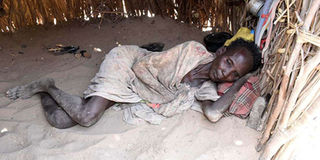Drought, Turkana deaths: West African ‘miracles’ can end it all

This image taken on March 17, 2019 shows Ms Ocheli Lemuu, a villager at Kamekwi in Turkana Central, in dire need of food. PHOTO | JARED NYATAYA | NATION MEDIA GROUP
What you need to know:
- The story of drought wasting Kenya’s northern and north-eastern regions has been a long-running one and is not likely to go away soon.
- A big part of the problem is that we are looking for solutions away from the affected communities. A change in mindset that looks to these communities’ history of resilience might offer us the best answers.
Last week, the sleekly produced One Planet Summit was held at the UN headquarters in Nairobi, co-hosted by President Uhuru Kenyatta and French leader Emmanuel Macron.
Barely had it closed than news hit the headlines of an environment-related disaster in Turkana, with reports of a severe drought in the county ravaging the people and plenty of skeletal people near death circulating on social media and the newspapers.
As of Tuesday, at least 10 people had died of hunger in the north-western Turkana region.
The government acknowledged that more than 1.1 million people are facing food shortages, with James Oduor of the National Drought Management Authority telling the BBC, however, that there was nothing unusual about one million people facing starvation.
“Due to poverty, almost under normal circumstances about a million people always require food assistance because... they are poor,” Oduor said.
BOTTOM-UP APPROACH
The story of drought wasting Kenya’s northern and north-eastern regions has been a long-running one and is not likely to go away soon.
In fact, with some of the bleak projections on climate change, it could get worse. The question of what to do to reverse course, or limit its damage, will become more frenzied. Perhaps it shouldn’t.
A big part of the problem is that we are looking for solutions away from the affected communities.
A change in mindset that looks to these communities’ history of resilience might offer us the best answers.
I remember an incident at Nation Media Group a while back, while I was still working there. Since the terrible droughts of the 1990s, NMG had a programme working with vulnerable communities in Turkana.
A MEAL A DAY
One element of it was bringing students from the area to Nairobi for a study and visitation trip. One time it brought a group of schoolgirls who were checked into a city hotel.
After a day or so, the company’s corporate affairs manager received an alarming call from the hotel. The Turkana girls, he was told, “had refused to eat”.
He rushed to the hotel, expecting to find the girls half-collapsed in hunger, but no. They were cheerful and playing away. He asked them why they had refused to eat. Their answer blind-sided him.
They told him that because in Turkana there is rarely ever more than a square meal a day in good times, they grew up learning to survive on just a meal a day.
Eating three meals a day at the hotel was “bad” for them because if their bodies got used to that, when they went back to Turkana, where they could only eat once a day, they would face harm. In other words, enough food was bad for them.
COPING
The point is not that the solution to the Turkana food crisis is to get people used to eating only one meal a day. Rather, that their circumstances have taught them to cope, and they have knowledge that could help avert crises.
Last year there was a report on Phys.org about what farmers in similar (in fact, worse) arid conditions in the Sahel had done.
It told the story of Richard Dick, a soil scientist at Ohio State, and his published study on a “tough shrub [that] could help fight hunger in Africa”, based on work in west Africa.
Growing these shrubs, called guiera, side-by-side with the food crop, millet, increased the grain’s output by more than a whopping 900 percent, it said.
While he did the scientific study, Dick didn’t pull it out of a hat: He got the cue from west African farmers, he said.
“Farmers there and in other parts of the African region, called the Sahel, have been allowing these shrubs to grow alongside crops to varying degrees — likely for thousands of years.”
RETHINK STRATEGY
Shortly after that, an article in The Guardian entitled “The great African regreening: Millions of ‘magical’ new trees bring renewal” reported similar dramatic results from “local knowledge” in a swathe of the continent.
“From the peanut basin of Senegal to the Seno plains of Mali, to Yatenga, formerly the most degraded region of Burkina Faso, and as far south as Malawi, gaos are thriving in Africa. And over the past three decades, the landscape of southern Niger has been transformed by more than 200m new trees, many of them gaos…on over 5m hectares of farmland, nurtured by thousands of farmers.
“According to scientists, what has happened in Niger — one of the world’s poorest countries — is the largest-scale positive transformation of the environment in the whole of Africa. This is not a grand UN-funded project aiming to offset climate change. Small-scale farmers have achieved it because of what the trees can do for crop yields and other aspects of farming life.”
Scratch out Sahel, write in Turkana.
Mr Onyango-Obbo is the publisher of Africapedia.com and explainer Roguechiefs.com. @cobbo3





